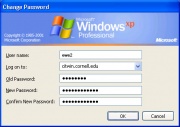Corporate Security and IT Policies
From Computing and Software Wiki
| Line 16: | Line 16: | ||
* Shredders | * Shredders | ||
* Mirrors on monitors | * Mirrors on monitors | ||
| - | |||
| - | |||
| - | |||
| - | |||
==Software Security== | ==Software Security== | ||
Revision as of 00:34, 13 April 2009
Corporations need to protect their physical and soft assets in today’s world of thieves and hackers. To do so, they implement IT and Security Policies, which protect their corporations against such attacks. These prevention mechanisms can be split up into three main categories: physical, software, and social (employees).
Contents |
Physical Security
Miniature mirrors are sometimes used on monitors to allow workers using a screen to see what’s behind them. The main purpose of these mirrors is to allow the user to view unwanted eyes from behind viewing confident information on the subject screen.
Security Cards are a common security feature, typically used on all entrances to secured buildings. Usually a public lobby-area with a receptionist is open for visitors, however, access to the remaining parts of the building are secured with a security system which requires authorized employees to swipe security passes to gain access.
Other self-explanatory physical security features include:
- Locks
- Cabinet Locks
- Badge Access
- Security Cameras
- Shredders
- Mirrors on monitors
Software Security
Software security refers to the protection of digital media; it includes hardware necessary to implement software security, such as a computer running the corporate firewall.
Social Employee Security
Although smaller companies sometimes omit discussion social engineering within their security practices, it is strikingly one of the most important areas to cover. Essentially, this type of security mechanism aims to prevent social engineering.
Companies typically have a statement in their security policy manual such as [X]:
Don't reveal a password to the boss
Don't talk about a password in front of others
Don't hint at the format of a password (e.g., "my family name")
Don't reveal a password over the phone to ANYONE
Don't reveal a password to co-workers while on vacation
If someone demands a password, refer them to this document or have them call someone in the Information Security Department.
Other Security measures
References
Some companies have statements of security as shown here: http://www.total.com/static/en/medias/topic1608/pol-sur-001_security_policy12.pdf
picture: http://www.rsscctv.com/images/P/200x200_tkc215_300%2520WEB.jpg
password change policy: http://support.netmail.sg/images/changepwd_owa2.gif
password Policy: http://www.sans.org/resources/policies/Password_Policy.pdf
http://en.wikipedia.org/wiki/Physical_Security
password change pic: http://www2.cit.cornell.edu/services/systems_support/images/changepassword2.jpg


